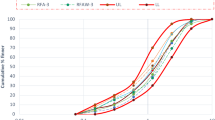Abstract
The present study investigated how the aggregate characteristics namely individual size, grade and type affects flowability of mortar mixes. Two types, river sand and crusher dust four single sizes namely 1.18 mm, 0.600 mm, 0.300 mm, 0.150 mm and for single gradation of each fine aggregate were considered in the present research work. In total, 103 mortar batches was made with three different sand to cement ratios [s/c] and two different water to cement ratios [w/c] to find out the flowability of mortar and tested using standard flow table. Out of 103 mortar batches, 52 were with river sand and 51 were with crusher dust. Tests were performed as per ASTM 109 standards. S/c ratio varied from 1 to 3 with an increment of one and w/c ratio was chosen in such a way that all the mixes to give measurable flow. The influence of particle shape and surface texture of aggregate were characterized with an angularity test based on ASTM C1252 in terms of percent of air voids in a loosely compacted fine aggregate. The results indicate that the size of aggregate and uncompacted void content have greater impact flowability of mortar. Mortar made with river sand has got better flowability than that of mortar made with crusher dust due to its higher degree of irregularities. Mortar with higher aggregate content has low percentage of spread compared to mortar with low aggregate content. Similarly, graded aggregate has lesser percentage of spread due to its proper packing compared to single sized aggregates.
Similar content being viewed by others
References
ASTM C109 (2008). Standard test method for compressive strength of hydraulic cement mortars, DOI: 10.1520/C0109_C0109M-08, www.astm.org.
ASTM C230 (2008). Standard specification for flow table for use in tests of hydraulic cement, DOI: 10.1520/C0230_C0230M-08, www.astm.org.
ASTM C1252 (2006). Standard test methods for uncompacted void content of fine aggregate (as influenced by particle shape, surface texture, and grading), DOI: 10.1520/C1252-06, www.astm.org.
ASTM Standard C33 (2003). Specification for concrete aggregates, ASTM International, West Conshohocken, PA, 2003, DOI: 10.1520/C0033-03, www.astm.org.
Brueggen, B., Kang, T. H. K., and Ramseyer, C. (2010). “Experimental and SEM analyses of ground fly ash in concrete”. International Journal of Concrete Structures and Materials. Vol. 4, No. 1, pp. 51–54.
Geiker, M. R., Brandl, M., Thrane, L. M., and Nielsen, L. F (2002). “On the effect of coarse aggregate fraction and shape on the rheological properties of self-compacting concrete.” Cement, Concrete, and Aggregate. Vol. 24, No. 1, pp. 3–6.
Hu, J. and Wang, K. (2007). “Effects of size and uncompacted voids of aggregate on mortar flowability.” Journal of Advanced Concrete Technology, Vol. 5, No. 1, pp. 75–85.
Malhotra, V. M. (1964). “Correlation between particle shape and surface texture of fine aggregates and their water requirement.” Materials Research & Standards, pp. 656–658.
Quiroga, P. N. (2003). The effect of aggregate characteristics on the performance of portland cement concrete, PhD Dissertation, The University of Texas at Austin, Austin
Smith, M. R. and Collis, L. (2001). Aggregates — Sand, gravel and crushed rock aggregates for construction purposes (3rd Edition), The Geological Society London, Chapter 8, pp. 199–224.
Szecsy, R. S. (1997). Concrete rheology, PhD Dissertation, University of Illinois at Urbana-Champaign, Urbana, IL.
Author information
Authors and Affiliations
Corresponding author
Rights and permissions
About this article
Cite this article
Harini, M., Shaalini, G. & Dhinakaran, G. Effect of size and type of fine aggregates on flowability of mortar. KSCE J Civ Eng 16, 163–168 (2012). https://doi.org/10.1007/s12205-012-1283-4
Received:
Revised:
Accepted:
Published:
Issue Date:
DOI: https://doi.org/10.1007/s12205-012-1283-4




